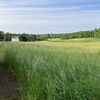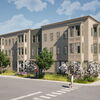Processing Your Payment
Please do not leave this page until complete. This can take a few moments.
- News
-
Editions
View Digital Editions
Biweekly Issues
- December 1, 2025
- Nov. 17, 2025
- November 03, 2025
- October 20, 2025
- October 6, 2025
- September 22, 2025
- + More
Special Editions
- Lists
- Viewpoints
-
Our Events
Event Info
Award Honorees
- Calendar
- Biz Marketplace
Collins, King push bill to accelerate R&D of building with wood
 Photo / James McCarthy
Anthony Thistleton, a founding partner of Waugh Thistleton Architects in London, touts cross-laminated timber as a renewable resource that can be engineered for many architectural uses. He's designed a 10-story, 121-unit building, now under construction in East London, that uses engineered timber. He was the keynote speaker at an October industry conference in Hiram.
Photo / James McCarthy
Anthony Thistleton, a founding partner of Waugh Thistleton Architects in London, touts cross-laminated timber as a renewable resource that can be engineered for many architectural uses. He's designed a 10-story, 121-unit building, now under construction in East London, that uses engineered timber. He was the keynote speaker at an October industry conference in Hiram.
Legislation backed by U.S. Sens. Susan Collins and Angus King calls for accelerated research and development of using new wood technologies, such as cross-laminated timber, in the construction of buildings over 85-feet high.
Collins and King have joined with Sens. Debbie Stabenow, D-Mich., and Mike Crapo, R-Idaho, in reintroducing the Timber Innovation Act, bipartisan legislation being pursued in both the U.S. Senate and House that aims to find new and innovative uses for wood as a building material.
The bipartisan bill is supported by Weyerhaeuser, which owns more than 13 million acres of timberland in the United States and acquired 1.8 million acres in Maine, Michigan, New Hampshire, Vermont and West Virginia through a merger with Plum Creek in 2016. National Wildlife Federation and the American Wood Council are among more than 100 other stakeholders supporting the bill. In Maine, the legislation is supported by the Maine Forest Products Council and the University of Maine School of Forest Resources.
“Our members support the Timber Innovation Act because Maine’s lumber, wood panels and cross-laminated timber will go into these tall buildings,” Patrick Strauch, executive director of the Maine Forest Products Council, said in a release. “Locally sourced wood from our sustainably managed forests provides a low-carbon, renewable and economical building solution. It’s an important part of our region’s growing green economy.”
“The use of Maine-sourced timber and engineered wood composites could be increased in important and developing construction applications such as mass timber non-residential structures,” said Stephen Shaler, director of the University of Maine School of Forest Resources. “This bill could help accelerate and expand Maine commercial manufacturing opportunities and associated engineering and architectural services. UMaine's expertise and R&D facilities are actively engaged and working with Maine industry in these sectors.”
Promising new wood construction technologies
Recent developments in wood products engineering alongside other new technologies are now making it possible to expand the use of wood into larger construction projects.
Anthony Thistleton, a founding partner of London-based Waugh Thistleton Architects and the keynote speaker at the Wood Innovators Conference in Hiram last fall, described how a nine-story, 29-unit apartment complex in London using prefabricated solid timber for its weight-bearing walls and flooring was erected in 27 days by four workers and a crane. And the Maine Forest Products Council devoted its annual meeting last fall to the potential of CLT and related engineered wood products such as nail laminated and glue-laminated timber in boosting the state's $8.5 billion forest products industry.
Incentivizing investment
Building on that momentum, the Timber Innovation Act would create incentives for investment through the National Forest Products Lab and American colleges and universities to conduct research and development on new methods for the construction of wood buildings.
The bill also would support ongoing efforts at the United States Department of Agriculture to further support the use of wood products as a building material for tall buildings.
“Maine is a goldmine of fiber, and all we need to do is work together to figure out new and innovative ways to put it to good use,” King said in a release. “This legislation will help do that by sparking research and development efforts for wood construction that will support Maine’s forest products industry, drive rural economies, and benefit the environment by reducing carbon emissions — a win for everyone involved.”
“Maine has an abundance of timber and a strong tradition of maintaining sustainable, working forests,” Collins added. “By promoting the research and development necessary to engineer wood for innovative uses in larger construction projects, this legislation would support Maine jobs, particularly in rural parts of the state, and invigorate our forest products industry.”
In addition to Collins and King, the legislation is also cosponsored by Sens. Maria Cantwell, D-Wash.; Steve Daines, R-Mont.; Klobuchar, D-Minn.; Jeff Merkley, D-Ore.; Gary Peters, D-Mich.; Jim Risch, R-Idaho; Jon Tester, D-Mont.; Ron Wyden, D-Ore.; and Roger Wicker, R-Miss.
Read more
Anchor tenant signs on at Millinocket's shuttered paper mill
Mainebiz web partners
Related Content

The Giving Guide
The Giving Guide helps nonprofits have the opportunity to showcase and differentiate their organizations so that businesses better understand how they can contribute to a nonprofit’s mission and work.
Learn More
Work for ME
Work for ME is a workforce development tool to help Maine’s employers target Maine’s emerging workforce. Work for ME highlights each industry, its impact on Maine’s economy, the jobs available to entry-level workers, the training and education needed to get a career started.
Learn More
Groundbreaking Maine
Whether you’re a developer, financer, architect, or industry enthusiast, Groundbreaking Maine is crafted to be your go-to source for valuable insights in Maine’s real estate and construction community.
Learn more-
The Giving Guide
The Giving Guide helps nonprofits have the opportunity to showcase and differentiate their organizations so that businesses better understand how they can contribute to a nonprofit’s mission and work.
-
Work for ME
Work for ME is a workforce development tool to help Maine’s employers target Maine’s emerging workforce. Work for ME highlights each industry, its impact on Maine’s economy, the jobs available to entry-level workers, the training and education needed to get a career started.
-
Groundbreaking Maine
Whether you’re a developer, financer, architect, or industry enthusiast, Groundbreaking Maine is crafted to be your go-to source for valuable insights in Maine’s real estate and construction community.
ABOUT
NEW ENGLAND BUSINESS MEDIA SITES
No articles left
Get access now
In order to use this feature, we need some information from you. You can also login or register for a free account.
By clicking submit you are agreeing to our cookie usage and Privacy Policy
Already have an account? Login
Already have an account? Login
Want to create an account? Register
Get access now
In order to use this feature, we need some information from you. You can also login or register for a free account.
By clicking submit you are agreeing to our cookie usage and Privacy Policy
Already have an account? Login
Already have an account? Login
Want to create an account? Register











Comments